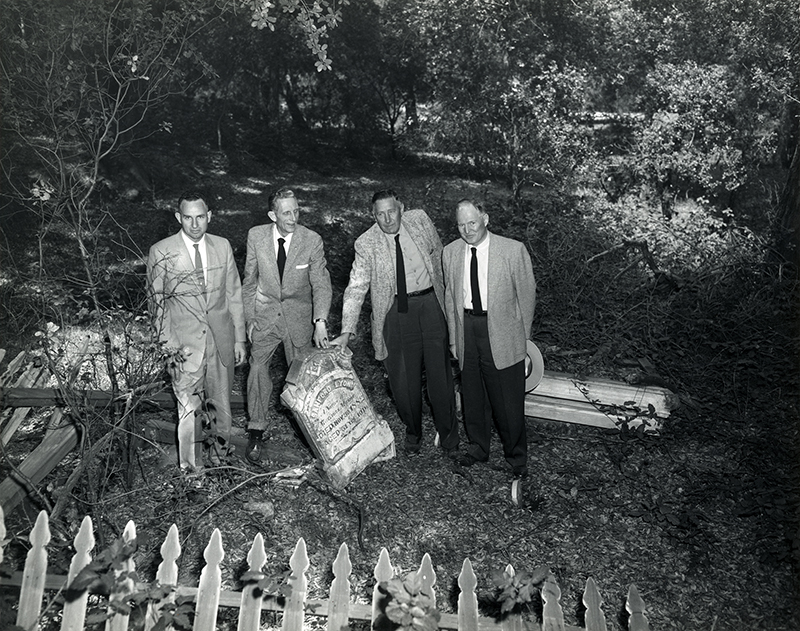
Click image to enlarge
| Download archival scan
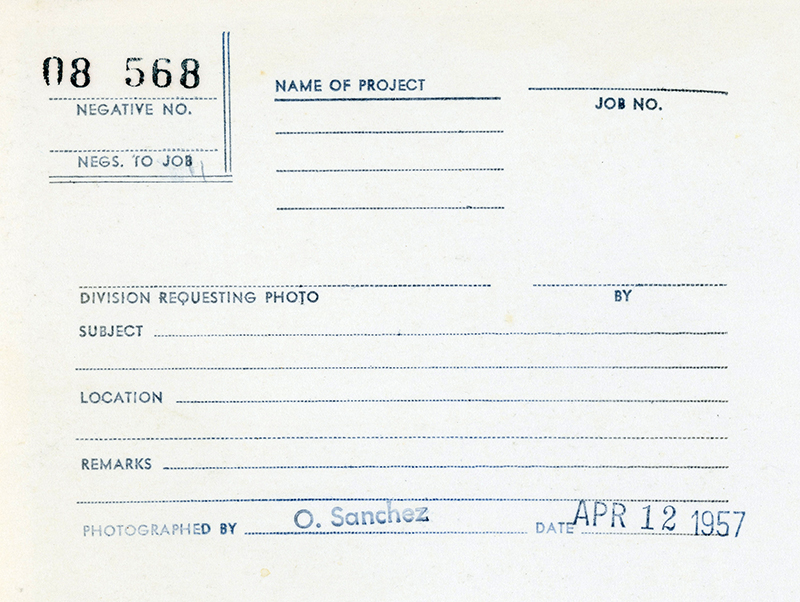
Click to enlarge.
|
April 12, 1957 —
Four unidentified men stand over the original gravesite of Newhall pioneer Sanford Lyon (as in Lyons Avenue) at the time of the sale of the 750-acre Needham Ranch to
Santa Monica morticians Gates, Kingsley and Gates Inc., who would develop Eternal Valley Memorial Park in the northeastern corner of the property. The headstones and remains of Lyon (1831-1882) and others
buried on the (pre-Needham) Lyon Ranch were moved a short distance to the Pioneer Cemetery section, aka Garden of Pioneers, by the time Eternal Valley opened in 1958.
8x10 photograph by O. Sanchez. No further information.
The seller of the Needham Ranch in 1957 was San Fernando Valley trash king Louis "Louie" Visco, father of Antelope Valley political kingmaker Frank Visco. The elder Visco
owned the property just long enough to enrage everybody in Newhall when he proposed to turn the Railroad Canyon (Pine Street) side into a giant trash dump. County Supervisor Warren Dorn
convinced his colleages to place a moratorium on building on unclassified land in his 5th supervisorial district until such time as a proper zoning plan was adopted for Newhall. (Most land in the
Soledad Township, aka Santa Clarita Valley, was unclassified.) The moratorium included landfills — prompting Visco to sell.
The cemetery eventually encompassed 220 acres and was sold in 1972. In the early 20th Century, Mark Gates Jr. — the "and Gates" part of the mortuary firm —
together with the new cemetery owner and local landowner Hank Arklin, developed half of the remaining 584 acres into the Gate-King (as in Gates-Kingsley) Industrial Park. (The numbers don't add up because the 584 acres include some Arklin property.) Gates and partners
gave the other half, the most densely wooded area with a
creek running through it, to the new City of Santa Clarita as permanent open space parkland.
The Gate-King environmental impact report provides some background:
In 1888, Kansas Governor John St.
John purchased over 10,000 acres from the Newhall Land and Farming Company and sent
Henry Clay Needham to establish the "St. John's Prohibition Colony." The dry colony failed,
but Henry Clay Needham remained in the area, permitting burials on his 750-acre property and
founding the Pearle [sic: Pearl] and Zenith Oil companies for oil drilling on the property. Numerous oil
wells were drilled on the Needham Ranch, with production continuing through 1990. In 1957,
Gates, Kingsley, and Gates purchased Needham Ranch. In 1958, the County of Los Angeles
approved the use of approximately 200 acres of the ranch for the Eternal Valley Cemetery. Eight
years later, the State of California purchased another 200 acres of the ranch for construction of
the Antelope Valley Freeway.
Salvage Tycoon Buys Needham Acres, Plans Huge Project.
Roofing paper plant one of many Visco ideas.
The Newhall Signal and Saugus Enterprise | Thursday, June 28, 1956.
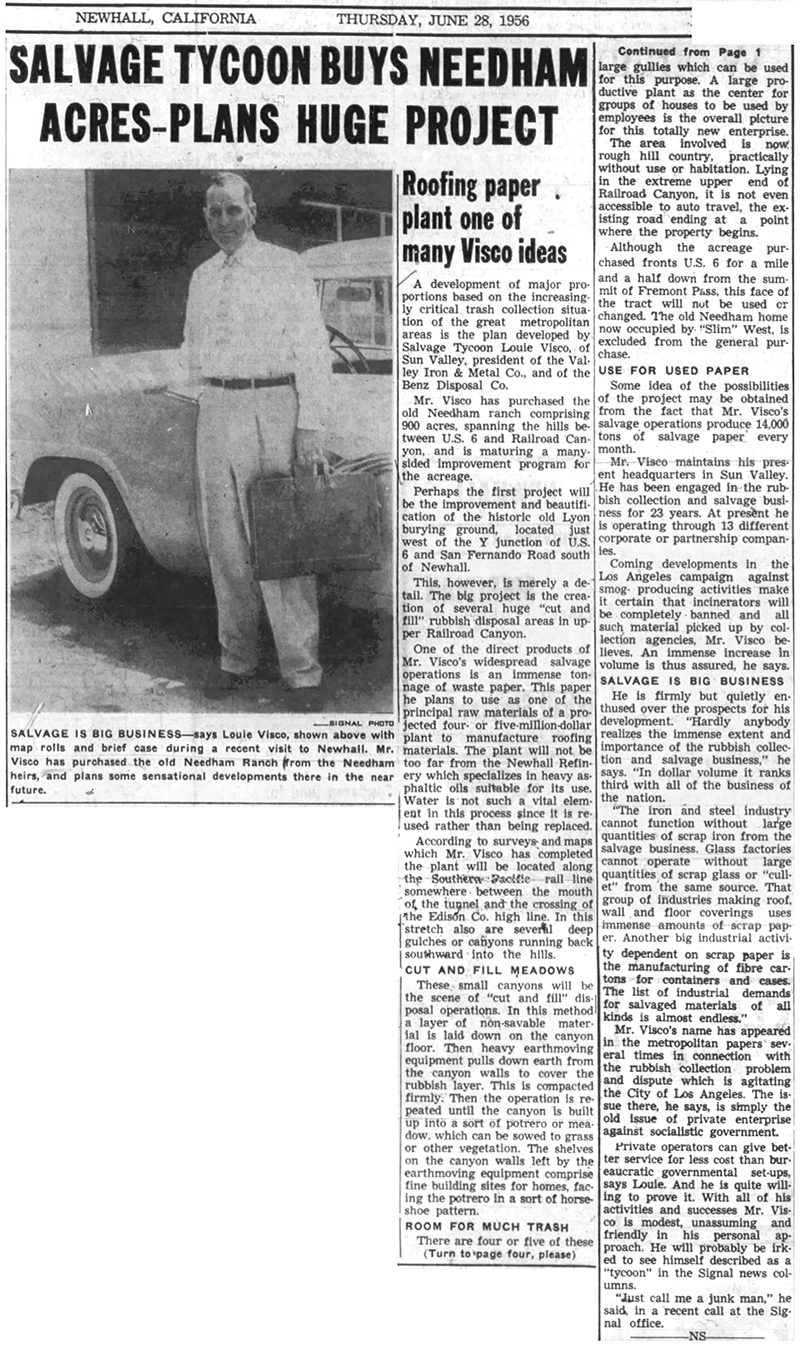
Click to enlarge.
|
A development of major proportions based on the increasingly critical trash collection situation of the great metropolitan areas is the plan developed by Salvage Tycoon Louie Visco of Sun Valley, president of the Valley Iron & Metal Co., and of the Benz Disposal Co.
Mr. Visco has purchased the old Needham ranch comprising 900 acres, spanning the hills between U.S. 6 and Railroad Canyon, and is maturing a many-sided improvement program for the acreage.
Perhaps the first project will be the improvement and beautification of the historic old Lyon burying ground, located just west of the Y Junction of U.S. 6 and San Fernando Road south of Newhall.
This, however, is merely a detail. The big project is the creation of several huge "cut and fill" rubbish disposal areas in upper Railroad Canyon.
One of the direct products of Mr. Visco's widespread salvage operations is an immense tonnage of waste paper. This paper he plans to use as one of the principal raw materials of a projected four- or five-million-dollar plant to manufacture roofing materials. The plant will not be too far from the Newhall Refinery, which specializes in heavy asphaltic oils suitable for its use. Water is not such a vital element in this process since it is reused rather than being replaced.
According to surveys and maps which Mr. Visco has completed, the plant will be located along the Southern Pacific rail line somewhere between the mouth the tunnel and the crossing of the Edison Co. high line. In this stretch also are several deep gulches or canyons running back southward into the hills.
These small canyons will be the scene of "cut and fill" disposal operations. In this method a layer of non-savable material is laid down on the canyon floor. Then heavy earthmoving equipment pulls down earth from the canyon walls to cover the rubbish layer. This is compacted firmly. Then the operation is repeated until the canyon is built up into a sort of potrero or meadow, which can be sowed to grass or other vegetation. The shelves on the canyon walls left by the earthmoving equipment comprise fine building sites for homes, facing the potrero in a sort of horseshoe pattern.
There are four or five of these large gullies which can be used for this purpose. A large productive plant as the center for groups of houses to be used by employees is the overall picture for this totally new enterprise.
The area involved is now rough hill country, practically without use or habitation. Lying in the extreme upper end of Railroad Canyon, it is not even accessible to auto travel, the existing road ending at a point where the property begins.
Although the acreage purchased fronts U.S. 6 for a mile and a half down from the summit of Fremont Pass, this face of the tract will not be used or changed. The old Needham home now occupied by "Slim" West is excluded from the general purchase.
Some idea of the possibilities of the project may be obtained from the fact that Mr. Visco's salvage operations produce 14,000 tons of salvage paper every month.
Mr. Visco maintains his present headquarters in Sun Valley. He has been engaged in the rubbish collection and salvage business for 23 years. At present he is operating through 13 different corporate or partnership companies.
Coming developments in the Los Angeles campaign against smog-producing activities make it certain that incinerators will be completely banned and all such material picked up by collection agencies, Mr. Visco believes. An immense increase in volume is thus assured, he says.
He is firmly but quietly enthused over the prospects for his development. "Hardly anybody realizes the immense extent and importance of the rubbish collection and salvage business," he says. "In dollar volume it ranks third with all of the business of the nation.
"The iron and steel industry cannot function without large quantities of scrap iron from the salvage business. Glass factories cannot operate without large quantities of scrap glass or 'cullet' from the same source. That group of industries making roof wall and floor coverings uses immense amounts of scrap paper. Another big industrial activity dependent on scrap paper is the manufacturing of fibre cartons for containers and cases. The list of industrial demands for salvaged materials of all kinds is almost endless."
Mr. Visco's name has appeared in the metropolitan papers several times in connection with the rubbish collection problem and dispute which is agitating the City of Los Angeles. The issue there, he says, is simply the old issue of private enterprise against socialistic government.
Private operators can give better service for less cost than bureaucratic governmental set-ups, says Louie. And he is quite willing to prove it. With all of his activities and successes, Mr. Visco is modest, unassuming and friendly in his personal approach. He will probably be irked to see himself described as a "tycoon" in the Signal news columns.
"Just call me a junk man," he said in a recent call at the Signal office.
News story courtesy of Stan Walker.
|
Alarm, Opposition Flame at Huge Railroad Cyn. Trash Dump.
The Newhall Signal and Saugus Enterprise | Thursday, August 30, 1956.
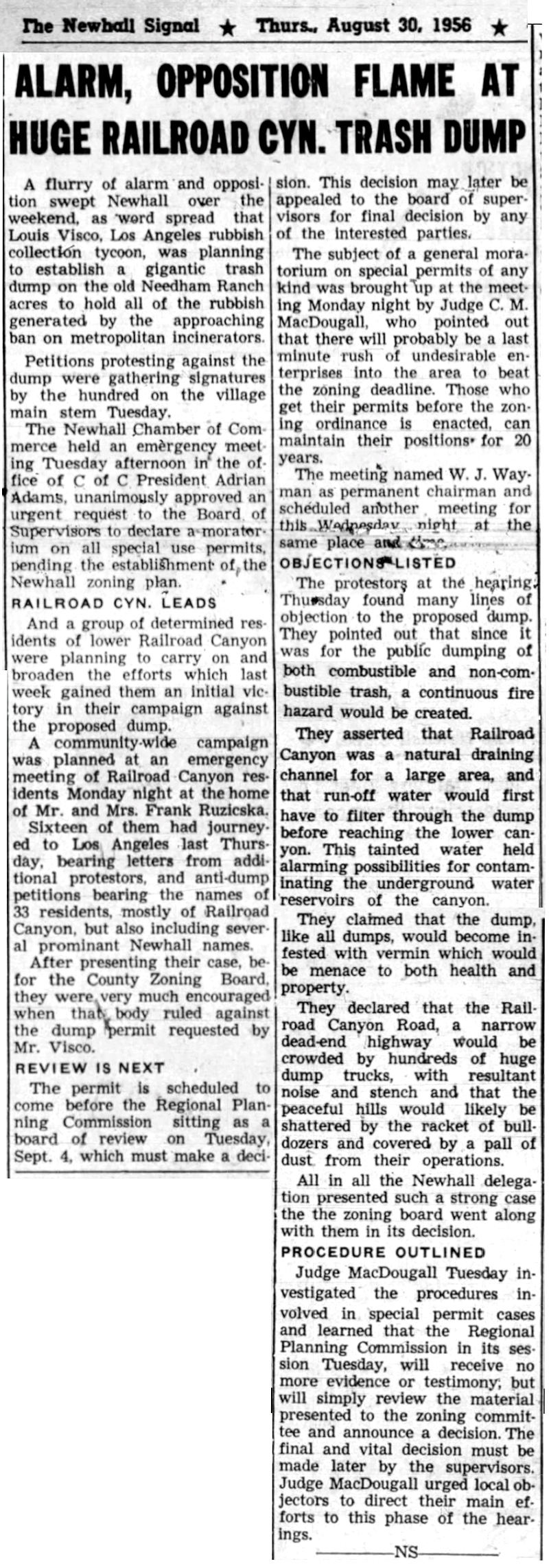
Click to enlarge.
|
A flurry of alarm and opposition swept Newhall over the weekend as word spread that Louis Visco, Los Angeles rubbish collection tycoon, was planning to establish a gigantic trash dump on the old Needham Ranch acres to hold all of the rubbish generated by the approaching ban on metropolitan incinerators.
Petitions protesting against the dump were gathering signatures by the hundred on the village mainstem Tuesday.
The Newhall Chamber of Commerce held an emergency meeting Tuesday afternoon in the office of C of C President Adrian Adams, unanimously approved an urgent request to the Board of Supervisors to declare a moratorium on all special use permits, pending the establishment of the Newhall zoning plan.
And a group of determined residents of lower Railroad Canyon were planning to carry on and broaden the efforts which last week gained them an initial victory in their campaign against the proposed dump.
A community-wide campaign was planned at an emergency meeting of Railroad Canyon residents Monday night at the home of Mr. and Mrs. Frank Ruzicska.
Sixteen of them had journeyed to Los Angeles last Thursday, bearing letters from additional protestors, and anti-dump petitions bearing the names of 33 residents, mostly of Railroad Canyon, but also including several prominent Newhall names.
After presenting their case before the County Zoning Board, they were very much encouraged when that body ruled against the dump permit requested by Mr. Visco.
The permit is scheduled to come before the Regional Planning Commission sitting as a board of review on Tuesday, Sept. 4, which must make a decision. This decision may later be appealed to the board of supervisors for final decision by any of the interested parties.
The subject of a general moratorium on special permits of any kind was brought up at the meeting Monday night by Judge C.M. MacDougall, who pointed out that there will probably be a last-minute rush of undesirable enterprises into the area to beat the zoning deadline. Those who get their permits before the zoning ordinance is enacted can maintain their positions for 20 years.
The meeting named W.J. Wayman as permanent chairman and scheduled another meeting for this Wednesday night at the same place and time.
The protestors at the hearing Thursday found many lines of objection to the proposed dump. They pointed out that since it was for the public dumping of both combustible and non-combustible trash, a continuous fire hazard would be created.
They asserted that Railroad Canyon was a natural draining channel for a large area, and that run-off water would first have to filter through the dump before reaching the lower canyon. This tainted water held alarming possibilities for contaminating the underground water reservoirs of the canyon.
They claimed that the dump, like all dumps, would become infested with vermin which would be menace to both health and property.
They declared that the Railroad Canyon Road, a narrow dead-end highway, would be crowded by hundreds of huge dump trucks, with resultant noise and stench, and that the peaceful hills would likely be shattered by the racket of bulldozers and covered by a pall of dust from their operations.
All in all, the Newhall delegation presented such a strong case [that] the zoning board went along with them in its decision.
Judge MacDougall Tuesday investigated the procedures involved in special permit cases and learned that the Regional Planning Commission, in its session Tuesday, will receive no more evidence or testimony, but will simply review the material presented to the zoning committee and announce a decision. The final and vital decision must be made later by the supervisors. Judge MacDougall urged local objectors to direct their main efforts to this phase of the hearings.
News story courtesy of Stan Walker.
|
|
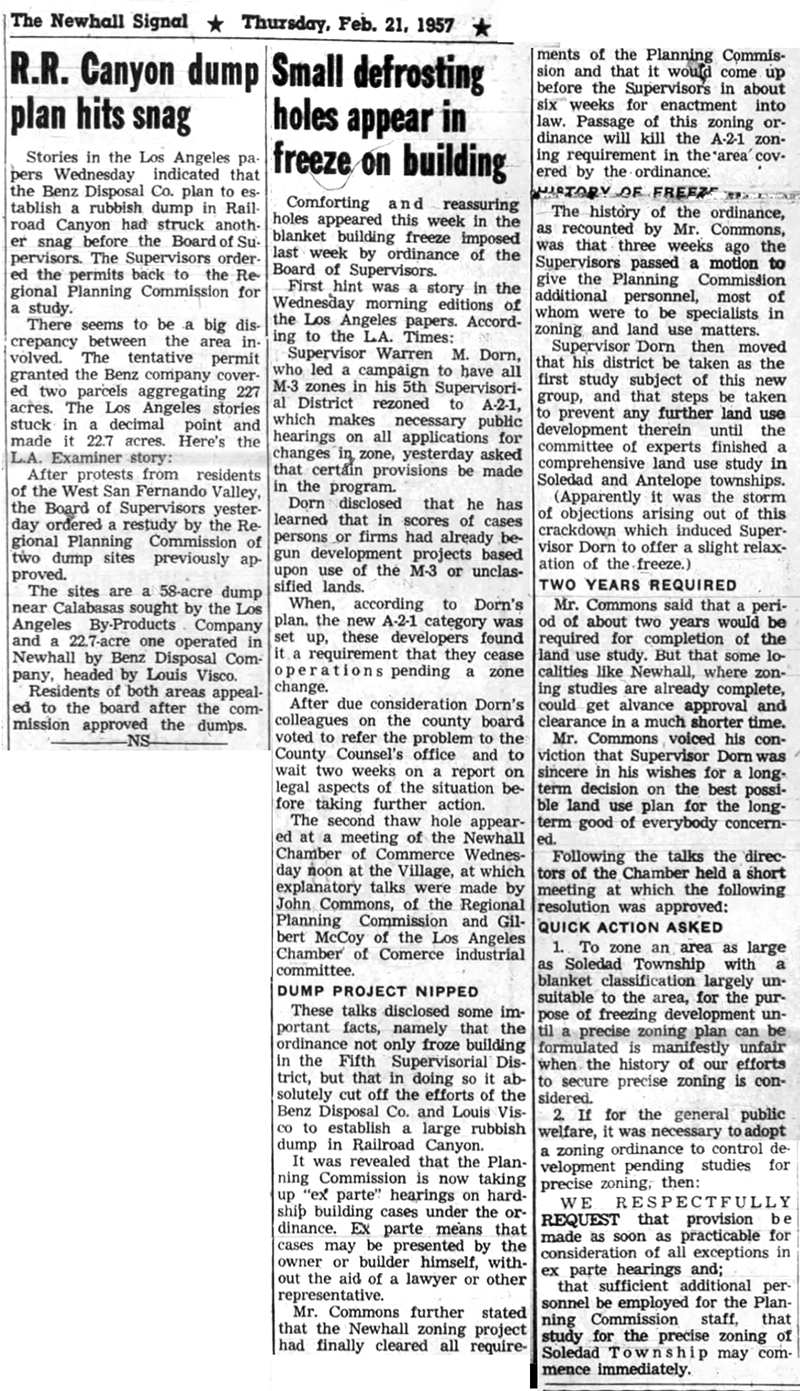
Click to enlarge.
|
R.R. Canyon Dump Plan Hits Snag.
The Newhall Signal and Saugus Enterprise | Thursday, February 21, 1957.
Stories in the Los Angeles papers Wednesday indicated that the Benz Disposal Co. plan to establish a rubbish dump in Railroad Canyon had struck another snag before the Board of Supervisors. The Supervisors ordered the permits back to the Regional Planning Commission for a study.
There seems to be a big discrepancy between the area involved. The tentative permit granted the Benz company covered two parcels aggregating 227 acres. The Los Angeles stories stuck in a decimal point and made it 22.7 acres. Here's the L.A. Examiner story:
After protests from residents of the West San Fernando Valley, the Board of Supervisors yesterday ordered a restudy by the Regional Planning Commission of two dump sites previously approved.
The sites are a 58-acre dump near Calabasas sought by the Los Angeles By-Products Company and a 22.7-acre one operated in Newhall by Benz Disposal Company, headed by Louis Visco.
Residents of both areas appealed to the board after the commission approved the dumps.
Small Defrosting Holes Appear in Freeze on Building.
The Newhall Signal and Saugus Enterprise | Thursday, February 21, 1957.
Comforting and reassuring holes appeared this week in the blanket building freeze imposed last week by ordinance of the Board of Supervisors.
First hint was a story in the Wednesday morning editions of the Los Angeles papers. According to the LA. Times:
Supervisor Warren M. Dorn, who led a campaign to have all M-3 zones in his 5th Supervisorial District rezoned to A-2-1, which makes necessary public hearings on all applications for changes in zone, yesterday asked that certain provisions be made in the program.
Dorn disclosed that he has learned that in scores of cases, persons or firms had already begun development projects based upon use of the M-3 or unclassified lands.
When, according to Dorn's plan, the new A-2-1 category was set up, these developers found it a requirement that they cease operations pending a zone change.
After due consideration, Dorn's colleagues on the county board voted to refer the problem to the County Counsel's office and to wait two weeks on a report on legal aspects of the situation before taking further action.
The second thaw hole appeared at a meeting of the Newhall Chamber of Commerce Wednesday noon at the [French] Village, at which explanatory talks were made by John Commons of the Regional Planning Commission and Gilbert McCoy of the Los Angeles Chamber of Commerce industrial committee.
These talks disclosed some important facts, namely that the ordinance not only froze building in the Fifth Supervisorial District, but that in doing so it absolutely cut off the efforts of the Benz Disposal Co. and Louis Visco to establish a large rubbish dump in Railroad Canyon.
It was revealed that the Planning Commission is now taking up "ex parte" hearings on hardship building cases under the ordinance. Ex parte means that cases may be presented by the owner or builder himself, without the aid of a lawyer or other representative.
Mr. Commons further stated that the Newhall zoning project had finally cleared all requirements of the Planning Commission and that it would come up before the Supervisors in about six weeks for enactment into law. Passage of this zoning ordinance will kill the A-2-1 zoning requirement in the area covered by the ordinance.
The history of the ordinance, as recounted by Mr. Commons, was that three weeks ago the Supervisors passed a motion to give the Planning Commission additional personnel, most of whom were to be specialists in zoning and land use matters.
Supervisor Dorn then moved that his district be taken as the first study subject of this new group, and that steps be taken to prevent any further land use development therein until the committee of experts finished a comprehensive land use study In Soledad and Antelope townships.
(Apparently it was the storm of objections arising out of this crackdown which induced Supervisor Dorn to offer a slight relaxation of the freeze.)
Mr. Commons said that a period of about two years would be required for completion of the land use study. But that some localities like Newhall, where zoning studies are already complete, could get advance approval and clearance in a much shorter time.
Mr. Commons voiced his conviction that Supervisor Dorn was sincere in his wishes for a long-term decision on the best possible land use plan for the long-term good of everybody concerned.
Following the talks, the directors of the Chamber held a short meeting at which the following resolution was approved:
1. To zone an area as large as Soledad Township with a blanket classification largely unsuitable to the area, for the purpose of freezing development until a precise zoning plan can be formulated is manifestly unfair when the history of our efforts to secure precise zoning is considered.
2. If for the general public welfare, it was necessary to adopt a zoning ordinance to control development pending studies for precise zoning; then:
WE RESPECTFULLY REQUEST that provision be made as soon as practicable for consideration of all exceptions in ex parte hearings and;
that sufficient additional personnel be employed for the Planning Commission staff, that study for the precise zoning of Soledad Township may commence immediately.
News story courtesy of Stan Walker.
|
|
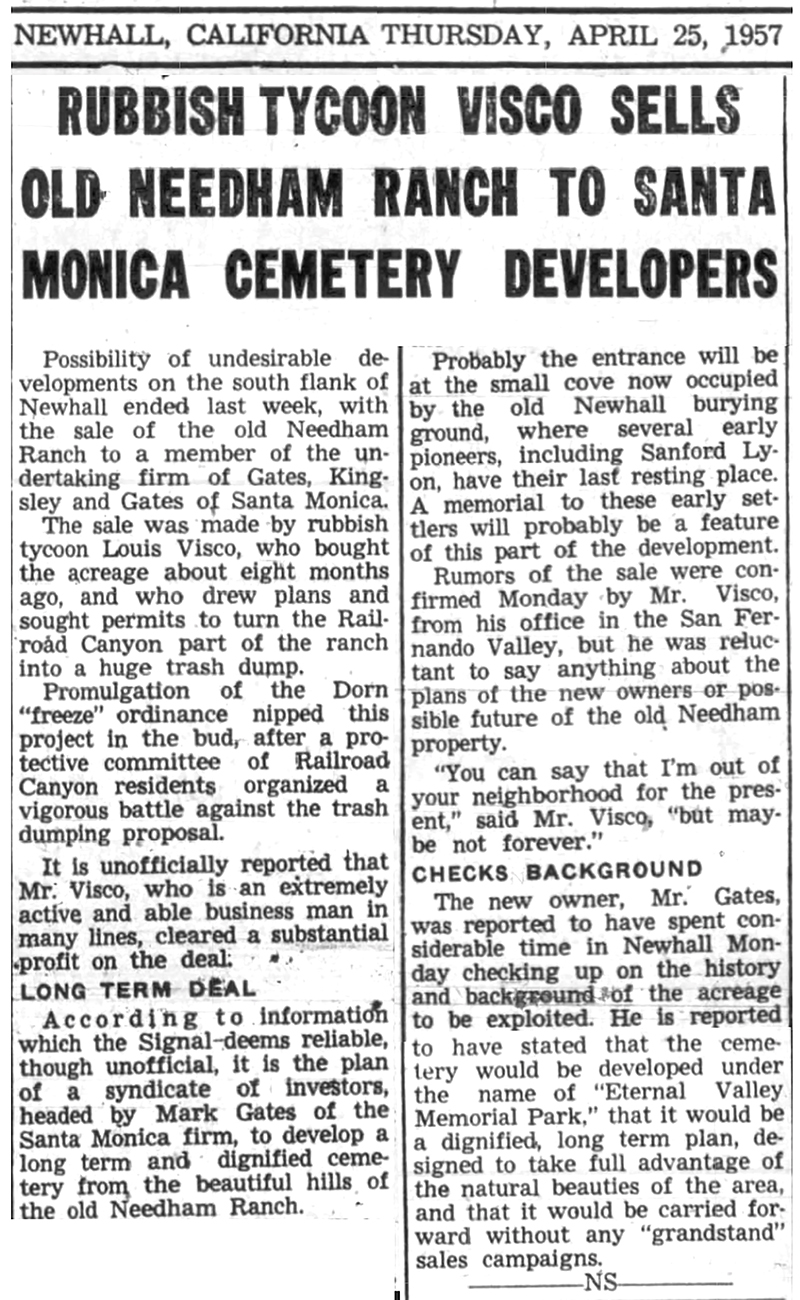
Click to enlarge.
|
Rubbish Tycoon Visco Sells Old Needham Ranch to Santa Monica Cemetery Devlopers.
The Newhall Signal and Saugus Enterprise | Thursday, April 25, 1957.
Possibility of undesirable developments on the south flank of Newhall ended last week, with the sale of the old Needham Ranch to a member of the undertaking firm of Gates, Kingsley and Gates of Santa Monica.
The sale was made by rubbish tycoon Louis Visco, who bought the acreage about eight months ago, and who drew plans and sought permits to turn the Railroad Canyon part of the ranch into a huge trash dump.
Promulgation of the Dorn "freeze" ordinance nipped this project in the bud, after a protective committee of Railroad Canyon residents organized a vigorous battle against the trash dumping proposal.
It is unofficially reported that Mr. Visco, who is an extremely active and able business man in many lines, cleared a substantial profit on the deal.
According to information which the Signal deems reliable, though unofficial, it is the plan of a syndicate of investors, headed by Mark Gates of the Santa Monica firm, to develop a long term and dignified cemetery from the beautiful hills of the old Needham Ranch.
Probably the entrance will be at the small cove now occupied by the old Newhall burying ground, where several early pioneers, including Sanford Lyon, have their last resting place. A memorial to these early settlers will probably be a feature of this part of the development.
Rumors of the sale were confirmed Monday by Mr. Visco, from his office in the San Fernando Valley, but he was reluctant to say anything about the plans of the new owners or possible future of the old Needham property.
"You can say that I'm out of your neighborhood for the present," said Mr. Visco, "but maybe not forever."
The new owner, Mr. Gates, was reported to have spent considerable time in Newhall Monday checking up on the history and background of the acreage to be exploited. He is reported to have stated that the cemetery would be developed under the name of "Eternal Valley Memorial Park," that it would be a dignified, long term plan, designed to take full advantage of the natural beauties of the area, and that it would be carried forward without any "grandstand" sales campaigns.
|
Water Dist. Moves for Annexation of Needham Ranch.

Click to enlarge.
|
The Newhall Signal and Saugus Enterprise | Thursday, August 15, 1957.
Through legal notice in this issue of the Signal, the Newhall County Water District gives advice of its intention to consider annexation of the 500 acres [sic] comprised of the old Needham Ranch south of town.
This ranch was recently purchased by Mark Gates, of a prominent mortuary firm in Santa Monica, for the purpose of transforming into a cemetery.
Since the beauty of any cemetery depends on green lawns, shrubbery and flowers, the Gates interests found a reliable and adequate water supply to be a basic necessity for their development.
District Supt. Charles Bonser said that he had been informed that the Gates firm planned to start with the improvement of ten acres which would require 56,000 gallons daily for irrigation.
The legal notice occupies four full columns in this issue of the paper, and is a detailed surveyors' techincal land description, not understandable by the layman. However, it is roughly the hilly area lying between U.S. 6, San Fernando Road and Railroad Canyon. It was originally purchased from the Needham estate by Louis Visco, rubbish tycoon, who proposed to put a cut-and-fill dump in Railroad Canyon. Violent and community wide objections blocked this project.
The new district well now being drilled in Railroad Canyon will be adjacent to this annexation and in a good position to serve it.
The board has set 7:30 p.m. Sept. 3 as the time, and the offices of the district at 24507 Spruce Street as the place for a public hearing for interested parties.
|
|

Click to enlarge.
|
Opposition Foils Annexation of Needham Acreage.
The Newhall Signal and Saugus Enterprise | Thursday, September 12, 1957.
Opposition to the proposed annexation of the Needham Ranch property to the Newhall Water district developed at the last regular meeting of the board in the District office on Tuesday, Sept. 3, it became known this week.
Because of the opposition of directors Fenton Westcott and Wallace Jones, united to protests registered by several citizens, the board postponed approval of the annexation, and named a committee to confer with Mark Gates, owner of the Needham acres, on a possible solution of difficulties.
The chief objections registered were along the lines that an agreement to furnish the tract with water might later result in a shortage of water for Newhall.
Mr. Gates, who was present at the meeting, presented figures to discount this view. He said that the proposed cemetery would begin with the development of only two acres, and that the maximum water consumption on these acres would be about 5,000 gallons per day for six days a week. He also pointed out that the Inglewood Cemetery, which started In 1906 with less than 300 acres, was still not using all of them for its purposes.
Named on a committee to confer farther with Mr. Gates were District Directors Dorothy MacNemar and Fenton Westcott. Mrs. MacNemar had indicated approval of the annexation proposal, and Westcott had strongly opposed it. Also speaking in opposition were T.M. Frew Jr. and Ralph Williams.
The proposal is scheduled to come up again at the next regular meeting of the board slated for October 1.
|
|

Click to enlarge.
|
No Water Shortage in Sight.
Signal Editorial Opinion.
The Newhall Signal and Saugus Enterprise | Thursday, September 19, 1957.
Newhall and the Little Santa Clara Valley had several super-hundred degree spells of hot weather during the summer. During these times the Newhall County Water District consistently delivered million-gallon-daily water quotas, and generally wound up every morning with two big reservoirs brimming with water for the demands to come.
Recently the District completed a well in Railroad Canyon capable of delivering at least another half-million gallons of water a day.
It is a bit hard to see, therefore, why anyone should work up a scare on water shortage, and oppose further annexations to the District.
It is quite true that conditions can be imagined, at some vague and unnamed time in the future, when demand will outrun supply, and shortages threaten. But that time is not now, nor at any time in the foreseeable future. It is also reasonable to suppose that new water sources will appear, as well as new demands.
Certainly no vast demand for water will arise from the County's development of the Horseshoe Ranch. The Needham Ranch acres, now owned by Mr. Gates, are to be the site of a modern and attractive public cemetery, something that this Valley has long needed. But it will start modestly, with only two or three acres, which certainly would not strain the water capacity of the district. The nature of the area is such that it is hardly ineligible for tract type, mass housing development.
In view of these demonstrable facts, it is a little bit difficult to figure the motives behind the anti-annexation campaign.
The community of Newhall is facing some gigantic competition not too far off in the future. There is no question that an attempt will be made to relegate Newhall to the status of a back street, fringe area business and residential district.
It would seem to be the part of wisdom for Newhall to promote its own growth in any and every way possible and do it now, while it is still possible.
|
Fred W. Trueblood III adds (2019):
One of the old Trueblood family stories is about Fred Sr., my grandfather, getting involved in the Gates acquisition when the property's water rights were not included in the sale.
I seem to remember that Needhams kept the water rights. In those days when my family first purchased the Newhall Signal and Saugus Enterprise my grandfather used to tell anyone who would listen
(and mostly everyone did) that the valley was in dire need of four things: 1. Its own high school. 2. A water system that was reliable (water would actually come out of a fire hydrant when you turned it on).
3. A functioning hospital for area citizens and 4. A place to bury our dead. When the Gates family acquired what is now Eternal Valley but faced inadequate water rights and a reluctant water district,
my grandfather stepped in using his bully pulpit to "persuade" Mr. Needham to release the property's water rights. The beautiful grounds that you see at Eternal Valley are a result.
In gratitude Mr. Gates deeded the two plots where my grandfather and grandmother are buried today.
HS0880: 9600 dpi jpeg from original 8x10 photograph, Santa Clarita Valley Historical Society collection.
|
|












